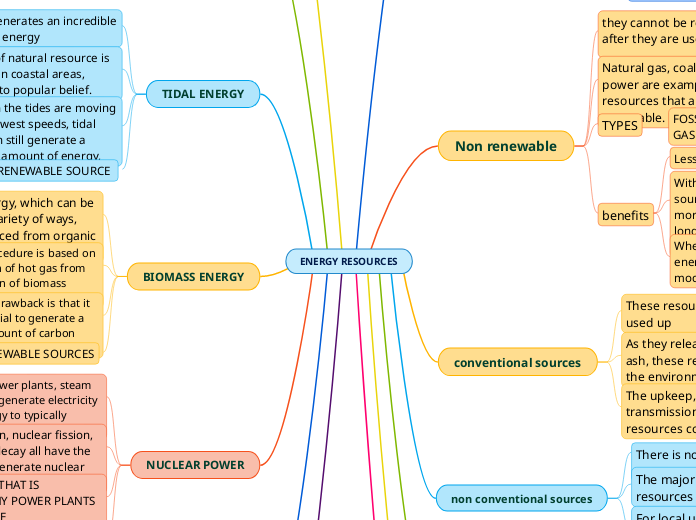
Renewable energy sources are those that can be repurposed after being exhausted.
Renewable resources include water, air, and solar energy.
renewable resources are unaffected by human activity.
TYPES
AIR, WATER , SOIL AND SOLAR ENERGY
BENEFITS
improvement in the power grid's resiliency, security, and reliability
Creation of employment opportunities in the renewable energy sectors reduced air pollution and carbon emissions from energy production boosted the United States' energy
expanded access to clean energy for coastal, islanded, or communities that are not connected to the grid.
cons
It costs a lot. When compared to other traditional resources,
It alters the environment's landscape.
The limited capacity of renewable resources poses a challenge in light of the Earth's environment.
they cannot be replenished after they are used up.
Natural gas, coal, and nuclear power are examples of resources that are not renewable.
TYPES
FOSSIL FUELS, COAL, NATURAL GAS
benefits
Less Initial Capital to Install
With nonrenewable energy sources, they can produce a more constant power supply, as long as the necessary fuel is available.
When it comes to nonrenewable energy sources, they are moderately cheap to extract.
These resources can never be used up
As they release smoke and ash, these resources pollute the environment.
The upkeep, storage, and transmission of these resources cost a lot
There is no end to these resources.
The majority of these resources are pollutant-free.
For local use, these resources are less expensive and simple to maintain.
Any dam or other structure that can raise the water level of a body of water above its natural level is an impoundment.
Impoundments can be used for
the establishment of a fresh reservoir and flood protection
When high-pressure condensate is discharged to a lower pressure, flash steam is produced. The way it is made is what gives it the name "flash."
Water boils at 100 degrees Celsius at atmospheric pressure.
Steam is typically utilized at a pressure higher than the pressure in the surrounding air in steam piping or any pressurized vessel.
Hydrogen economy is an economy that relies on hydrogen as the commercial fuel that would deliver a substantial fraction of a nation’s energy and services
The sun's energy is collected by solar panels and converted into electricity by solar energy
it is also possible to use power from small substations that are supplied by solar energy through enormous panel fields located, for instance, in deserts.
IT IS A PART OF RENEWABLE SOURCES
Geothermal energy is a type of renewable energy that is produced within the ground
As a result, steam is enabling the ground turbines to function and generate electricity as the hot rocks transform the core water into steam.
Geothermal energy can only be generated in specific locations.
RENEWABLE SOURCES
The tide generates an incredible amount of energy
This kind of natural resource is best used in coastal areas, according to popular belief.
Even when the tides are moving at their slowest speeds, tidal energy can still generate a significant amount of energy,
RENEWABLE SOURCE
Biomass energy, which can be utilized in a variety of ways, can be produced from organic materials.
The entire procedure is based on the production of hot gas from the combustion of biomass materials
This source's drawback is that it has the potential to generate a significant amount of carbon dioxide.
RENEWABLE SOURCES
.In nuclear power plants, steam turbines that generate electricity use this energy to typically generate heat
Nuclear fusion, nuclear fission, and nuclear decay all have the potential to generate nuclear power.
THE ENERGY THAT IS PRODUCED NY POWER PLANTS IS RENEWABLE
THE FUEL REQUIRED IS NON RENWABLE.
The one-of-a-kind nuclear reaction results in the production of this energy.
Ocean energy could well be one of these new renewable energy sources and should really play more significant role in upcoming years.
We can use the waves (wave energy, wave power), ocean tidal power (ocean high and low tides),
Hydro energy simply consists of energy extracted from water and converted into electricity
There are numerous capture methods for hydropower. A hydroelectric dam is the most common way to harness the power of water.